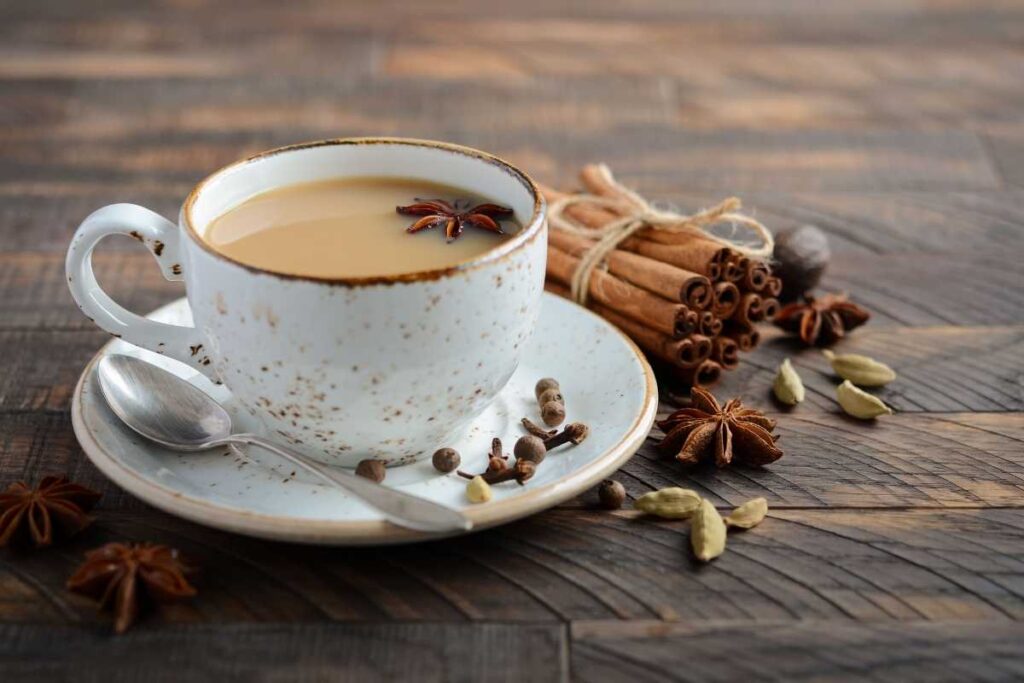Tea with Milk: The Science Behind a Perfect Blend

Adding milk to tea is a practice that has been around for centuries. It is believed that milk was first added to tea in the early 19th century, as part of the brewing process in China. This theory quickly spread across the world and became a sign of wealth and status, especially when drinking the popular drink in India and the United Kingdom. However, the cultural significance of adding milk to tea varies depending on the country and region.
Why add milk to tea drink? There are several reasons why people add milk to their tea brewing. One reason is that it can help to cool down the hot tea heat so that it can be consumed more quickly. Some people prefer the taste of tea with milk as opposed to without it, especially when dealing with strong tannins. Milk can also help to mellow out the bitterness of certain types of teas.
Why put milk in tea? It’s a popular drink recipe that has been enjoyed for centuries. Some people prefer to add a squeeze of lemon to their tea, while others love to pair it with scones. There are different ways in which people put milk in their tea. Some people prefer to pour cold milk into their hot tea while others prefer to heat up the milk first before adding it into their tea. The amount of milk used can also vary depending on personal preference.
Who adds milk to tea? Adding milk to tea is a common practice among many different cultures and regions. In fact, this drink has become so popular that people have started creating their own unique recipes for it. However, it’s important to note that adding milk to tea can reduce the amount of tannins present in the beverage. If you’re looking for a unique twist on your tea, try adding a dollop of jam to your cup before pouring in the milk – it’s a delicious combination!
The Proper Way to Add Milk to Tea: Tips and Tricks
Adding milk to tea is a recipe that has been around for centuries, and it’s no surprise that it has become a staple in many tea-drinking cultures. Whether you prefer black tea or green tea, adding milk and brown sugar can enhance the flavor and texture of your brew. For an extra zing, try adding a slice of lemon or a dollop of jam. However, there is an art to adding milk to tea properly. Here are some tips and tricks on how to do it right.
Firstly, timing is everything when it comes to adding milk to tea. It’s best to wait until the tea has brewed for a few minutes before pouring in the milk. This allows the flavors of the tea leaves to infuse fully before being diluted by the addition of milk. For a perfect afternoon drink, pair your tea with some scones and a squeeze of lemon.
When following a scone recipe, whole milk or dairy-free alternatives such as almond or soy milk are great options for a creamier taste. However, be mindful not to add too much milk as it can dilute the flavor of the scones. For a refreshing twist, serve the scones with a side of lemon curd or jam.
Stirring your tea gently while adding in your preferred amount of milk is also important in any scones recipe. Doing so helps prevent curdling and ensures that the flavors are evenly distributed throughout your cup, whether you’re enjoying it with a lemon glaze or not.
For those who enjoy using teabags instead of loose leaf teas, making good quality tea with milk is still possible. Simply follow this recipe: brew your teabag in hot water first before waiting a few minutes before adding in your desired amount of milk. Enjoy your tea with some delicious scones!
Lastly, if you’re feeling adventurous and want to try a new recipe, green tea scones with added milk can be surprisingly delicious! Green teas tend to have more delicate flavors than black teas, so using less milk or opting for lighter dairy-free options like oat or rice milks would be ideal.
Understanding the Science Behind Adding Milk to Tea: Effects on Antioxidants and Caffeine
Adding milk to tea is a common practice around the world, especially when enjoying a recipe of freshly baked scones. But have you ever wondered about the science behind it? While it may enhance the taste and flavor of tea for some, adding milk can also affect its antioxidant activity and caffeine content.
When we follow a recipe and add milk to tea, it can reduce the antioxidant activity of tea. Tea contains polyphenols, which are natural compounds that act as antioxidants in our body. However, when we add milk to tea based on a recipe, the proteins in milk bind with these polyphenols and reduce their bioavailability. A study conducted by researchers at Purdue University found that adding milk to black tea according to a recipe reduced its antioxidant activity by up to 18%.
Another effect of adding milk to tea is on its astringency in a recipe. Tannins are natural compounds present in tea that give it a bitter taste and dry feeling in the mouth. When we add milk to tea in a recipe, tannins bind with proteins in milk instead of binding with our saliva proteins, reducing the astringency of tea. This is why many people prefer adding milk to strong black teas like Assam or Darjeeling in their recipe.
The addition of milk to your tea or coffee recipe can also decrease the amount of caffeine available for absorption. Caffeine is a natural stimulant present in both beverages that helps us stay alert and focused. However, when we add milk to these recipes, it can form complexes with caffeine molecules and make them less soluble in water. As a result, less caffeine is available for absorption into our bloodstream.
While there are some benefits of adding milk to tea such as reducing bitterness and enhancing flavor for some people; however, there are also drawbacks such as reduced antioxidant activity and decreased caffeine availability which might have an impact on health benefits.
Exploring Different Types of Milk Tea: Whole, Skim, Soy, and More
Whole milk, skim milk, soy milk, almond milk – there are so many options when it comes to choosing the perfect type of milk for your tea. Each type of milk has its own unique flavor and texture that can enhance or detract from the overall taste of your tea.
For those who love bubble tea, whole milk is a popular choice due to its richness and creaminess. It adds a luxurious mouthfeel to the drink that pairs perfectly with chewy tapioca pearls. However, if you’re looking for a healthier option, skim milk is a great choice. It still adds a creamy texture to your tea but with fewer calories than whole milk.
Soy milk is an excellent alternative for those who are lactose intolerant or vegan. It also has a nutty flavor that can add depth to your tea. Almond milk is another dairy-free option that pairs well with black tea and adds a subtle nuttiness to the drink.
When making any type of milk tea, fresh ingredients are key. Be sure to use high-quality loose leaf tea leaves and fresh milk for the best results. You can also experiment with different types of teas such as black, green, or oolong to find the perfect pairing with your preferred type of milk.
If you’re curious about bubble tea specifically, it’s typically made with black or green tea mixed with sweetened condensed milk and served over ice with tapioca pearls at the bottom of the cup. Taro milk tea is another popular variety that uses taro root powder mixed with either regular or non-dairy milks.
The History of Adding Milk to Tea: From India to Britain and Beyond
Adding milk to tea is a practice that has been around for centuries. It is a simple way to enhance the flavor of tea and reduce its bitterness. The origins of this practice can be traced back to India, where people have been adding milk to their tea for centuries.
The British popularized the addition of milk to tea in the 18th century when they began importing large quantities of tea from China and India. They found that adding milk helped to temper the strong, bitter taste of black tea. This allowed them to enjoy more cups of tea throughout the day without experiencing any negative effects.
The tradition of adding milk to tea quickly spread throughout Britain and eventually made its way across the globe. Today, many cultures around the world add milk or cream to their tea as a matter of course. In some countries, such as Hong Kong and Taiwan, it is even customary to serve sweetened condensed milk with black tea.
Despite its widespread popularity, there is still some debate over whether one should add milk first or last when making a cup of tea. Some people believe that adding the milk first helps it blend more evenly with the hot water, while others argue that adding it last allows you greater control over how much you add.
Regardless of which method you prefer, there is no denying that adding milk can greatly enhance your enjoyment of a good cup of tea. So next time you brew up a pot, consider giving this time-honored tradition a try!
Debunking Myths About Adding Milk to Tea: Does It Really Ruin the Flavor?
Adding milk to tea has been a topic of debate for many years. Some people believe that it ruins the flavor of tea, while others argue that it enhances it. The truth is, adding milk to tea doesn’t necessarily ruin the flavor. In fact, in some cases, milk can even enhance the flavor of certain types of tea.
The type of tea and the amount of milk used can affect the taste. For example, black teas such as English Breakfast or Assam are often served with milk because their robust flavor pairs well with the creaminess of milk. On the other hand, green and white teas are usually not served with milk because they have a delicate flavor that could be overwhelmed by the addition of dairy.
Milk can also help balance out bitterness in some teas. For instance, adding a splash of milk to Earl Grey tea can help mellow out its strong bergamot flavor and reduce any bitterness. Similarly, adding a bit of milk to chai tea can help balance out its spicy notes.
Ultimately, whether or not you add milk to your tea comes down to personal preference. Some people prefer their tea black and without any additions, while others enjoy a touch of sweetness from honey or sugar and creaminess from milk.
It’s important to note that if you do decide to add milk to your tea, using high-quality ingredients can make all the difference in terms of taste. Opt for fresh whole milk or non-dairy alternatives like almond or oat milk for a creamy texture and rich taste.
Health Benefits and Risks of Adding Milk to Tea: What Research Shows
Studies have shown that adding milk to tea can provide numerous health benefits. For one, it can reduce the risk of heart disease. A study conducted in the Netherlands found that individuals who drank tea with milk had a lower risk of developing heart disease than those who consumed black tea without milk. The researchers suggested that the proteins in milk may bind to the polyphenols in tea, preventing them from oxidizing and thus preserving their beneficial effects on cardiovascular health.
In addition to reducing the risk of heart disease, there are other benefits associated with drinking tea with milk. For instance, adding milk to your cup of tea can increase bone strength and density. This is because both tea and milk contain calcium, which is essential for maintaining healthy bones.
Drinking tea with milk can also aid digestion by soothing irritation in the stomach lining. The proteins in milk act as a natural antacid, neutralizing stomach acid and providing relief from discomfort caused by indigestion or heartburn.
However, while there are many benefits to drinking tea with milk, research suggests that this practice may decrease the antioxidant properties of tea. Antioxidants are compounds found in foods like fruits and vegetables that protect cells from damage caused by free radicals. Tea contains high levels of antioxidants called catechins, which have been linked to a reduced risk of chronic diseases such as cancer and Alzheimer’s.
Unfortunately, when you add milk to your cup of tea, these catechins may be neutralized or destroyed altogether. One study found that adding whole milk to green tea decreased its antioxidant activity by up to 18%. Another study showed that adding skimmed or semi-skimmed milk had less impact on antioxidant activity but still reduced it by up to 25%.
Enjoying a Perfect Cup of Tea with Milk
Enjoying a Perfect Cup of Tea with Milk is an art that requires patience and attention to detail. From choosing the right type of milk to adding it at the perfect temperature, there are many factors that can affect the taste and quality of your tea with milk. Whether you prefer a strong black tea or a delicate green tea, there’s no denying that adding milk can enhance its flavor and texture. So next time you brew a cup of tea with milk, take your time and savor every sip. With the tips and tricks we’ve shared in this post, you’ll be able to create a delicious cup of tea with milk that’s just right for you. Cheers!




